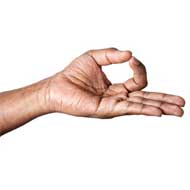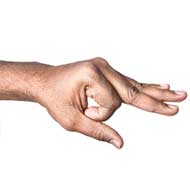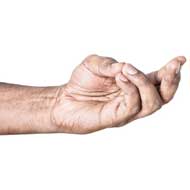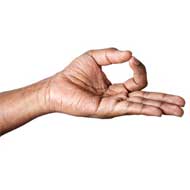The meaning of ‘mudra’, which is a Sanskrit word, is ‘closure’ or
‘seal’. Mudra hand positions are physical gestures that have an effect
on the energy flow of the body.
The ancient practice of yoga links the hand mudras to the changing
spiritual and mental aspects of a person. The mudras are usually finger
positions like in the Anjali Mudra, where the hands are kept at the
center of the heart.
Practicing the different types of mudras for health is considered
good as it provides physical, mental, as well as spiritual benefits.
Mudras, also known as hand yoga, typically involves placing the hands
and fingers in certain positions as described in the Vedas.
Types of mudras
The various types of mudras are as follows.
- Gyan mudra:
The gyan mudra raises the level of the element vayu or air in the body.
This mudra is done by joining together the tip of the thumb and the
index finger.
- Prana mudra:
The pran mudra helps in increasing vitality and in the activation of
the root chakrar To perform this mudra, you should keep the tips of your
little finger, ring finger and thumb togethere The middle and index
finger should remain extended.
- Vayu mudra:
The meaning of vayu is ‘wind’, and this mudra is aimed specifically at
getting rid of flatulencee It is said to produce immediate resultsu
However, once the problem is relieved you should stop doing the pose
- Prithvi mudra:
This mudra helps in activating the root chakrac The root chakra holds
the elemental force of vital energye Some of the benefits of the prithvi
mudra are increased energy, inner stability, and strengthening of the
mind and body
- Chin mudra:
The chin mudra is used in breathing exercises like Ujjayi Pranayama or
in seated meditationd This mudra is effective for lower back pain,
reducing stress, and for headaches
- Apaan mudra:
The apaan mudra is a very useful and important mudra that detoxifies
the body and then energizes ite Some of the benefits of apaan mudra are
for constipation, anuria, and delayed child delivery
- Surya mudra:
The surya mudra helps decrease the earth element and increase the fire
element in the body It is effective in regulating the metabolism and
body temperature
- Shunya mudra:
To perform this mudra, you should keep the thumb on the middle finger,
while the remaining fingers are kept straight The benefits of this
mudra include dealing with numbness in the body, vertigo, deafness, and
earaches
- Linga mudra:
The linga mudra strengthens the immune system of the body and loosens
the collected mucous in the bodyc This mudra is also effective for
weight loss because of the generation of heat
- Ganesha mudra:
The ganesha mudra symbolizes strength when faced with troublesa You
should practice this mudra dailye It helps stimulate the metabolism and
digestion
- Mandala mudra:
The mandala mudra is practiced to symbolize the offering of the whole
physical universe to the enlightened teachers and Buddha Although this
pose is not created by the deities, it is employed extensively in the
practice of ritual visualization called ‘mandala offering’
- Shankh mudra: You can find this mudra in Hindu temples as symbols
This mudra is very effective for throat problemsv The clasping
positioning of the fingers in this mudra simulates a conch shelli
- Rudra mudra:
To perform this mudra, you should keep the tips of the ring finger and
index finger on top of the thumbs tipo The other fingers should be
comfortably extended
- Apan vayu mudra: This mudra is used in heart attacks as first aidh Regular practice of this mudra can help strengthen the heart
- Surahi mudra:
To perform this mudra, you should join the little fingers of both hands
togethern The middle finger and forefinger should also be joined
togethero Keep the thumbs free
- Surabhi mudra:
You can perform this mudra thrice a day for 15 minutesr This mudra is
effective in dealing with rheumatic inflammation and helps increase
intellect
- Hakini mudra:
This mudra helps improve coordination between the left and right
hemispheres of the braind You can practice this mudra at anytime and
anyplace
- Bronchial and asthma mudra: These
mudras are effective for respiratory conditions. You can practice them
for a few minutes consecutively, till the breathing calms down
- Back mudra: This mudra is very effective for dealing with backache You can practice this mudra with both hands
- Kundalini mudra:
This mudra helps awaken the sexual force and unifies the feminine and
masculine. You can practice this mudra thrice a day for 15 minutes
- Khechari mudra:
Practicing this mudra enables the release of neurotransmitters like
dopamine This helps bring about a state of well being and calmness
- Yoni mudra:
This mudra is used to bring isolation to your senses and keep you from
distractions This can help you look inward with a calm and relaxed
mind
- Jnana mudra: In this mudra, the hands
with the palms facing up are kept on the knees in the seated positiont
This mudra gives a spacious feeling and uplifts the mind and body
Yoga mudra and five vital elements
Yoga
mudra and the five vital elements of the body have a close
relationship. The mudras can be used to balance the five vital elements
of the body, which are water, earth, ether, air, and fire. Any
deficiency or excess of each element can cause a disorder and imbalance
in the mind and body. The thumb represents fire, the index finger
represents air, the middle finger represents ether, the ring finger
represents earth, and the little finger represents water.
Benefits of mudras
The mudras benefit the bio magnetic fields, psyche, body, and mind in many ways. Some of the benefits of mudras are as follows:
-
The mudras clear the psychic centers and subtle channels in the body
This allows the life force to flow freely to the various parts of the
body
- The mudras purify the body’s bio magnetic field and shield it from negative forces
Purpose of mudras
The purpose of mudras is to bring about a complete regeneration and
transformation of the body-mind principle and an expansion of the
consciousness. However, make sure that you consult your doctor before
practicing yoga mudras. This is because certain conditions like diabetes
can worsen with the practice of yoga mudras.




